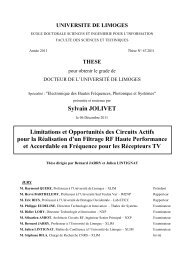Contribution à la conception optimale en terme de linéarité et ...
Contribution à la conception optimale en terme de linéarité et ...
Contribution à la conception optimale en terme de linéarité et ...
You also want an ePaper? Increase the reach of your titles
YUMPU automatically turns print PDFs into web optimized ePapers that Google loves.
Liste <strong>de</strong>s figures<br />
********<br />
Figure I.1 – Principe <strong>de</strong> <strong>la</strong> mesure <strong>en</strong> pulsé ............................................................................... 7<br />
Figure I.2 – Mesure <strong>de</strong>s paramètres S <strong>en</strong> impulsions................................................................. 8<br />
Figure I.3 – schéma compl<strong>et</strong> du banc <strong>de</strong> mesure par impulsion jusqu’<strong>à</strong> 40 GHz...................... 9<br />
Figure I.4 – Caractéristiques statiques (mesure <strong>en</strong> continu <strong>et</strong> <strong>en</strong> impulsion)........................... 11<br />
Figure I.5 – Caractéristiques statiques <strong>à</strong> état thermique fixe (<strong>en</strong> impulsion)........................... 11<br />
Figure I.6 – Structure d’un MESFET....................................................................................... 12<br />
Figure I.7 – Modèle non-linéaire électrothermique pr<strong>en</strong>ant <strong>en</strong> compte les eff<strong>et</strong>s <strong>de</strong> pièges.... 13<br />
Figure I.8 – Influ<strong>en</strong>ce <strong>de</strong>s modèles <strong>de</strong> pièges <strong>et</strong> thermiques.................................................... 15<br />
Figure I.9 – Influ<strong>en</strong>ce <strong>de</strong> <strong>la</strong> partie dynamique basse fréqu<strong>en</strong>ce du modèle ............................. 16<br />
Figure I.10 – Principe <strong>de</strong> <strong>la</strong> boucle active................................................................................ 18<br />
Figure I.11 – répartition <strong>de</strong>s impédances ................................................................................. 19<br />
Figure I.12 – Banc <strong>de</strong> mesure load-pull multiharmonique (boucle active).............................. 20<br />
Figure I.13 – Mesure du NPR .................................................................................................. 21<br />
Figure I.14 – Synoptique du banc <strong>de</strong> mesure ........................................................................... 23<br />
Figure I.15 – Signal avant <strong>et</strong> après modu<strong>la</strong>tion........................................................................ 24<br />
Figure I.16 – Synoptique du banc <strong>de</strong> mesure ........................................................................... 26<br />
Figure I.17 – Comparaison <strong>de</strong>s bancs <strong>de</strong> NPR......................................................................... 27<br />
Figure I.18 – Principe d’analyse par le gain complexe ............................................................ 30<br />
Figure I.19 Caractéristiques AM/AM <strong>et</strong> AM/PM d’un amplificateur ..................................... 30<br />
Figure I.20 – Réponse <strong>à</strong> un échelon d’un système avec <strong>et</strong> sans mémoire................................ 31<br />
Figure I.21 – Influ<strong>en</strong>ce <strong>de</strong>s constantes <strong>de</strong> temps sur les produits d’intermodu<strong>la</strong>tion .............. 32<br />
Figure I.22 – Principe d’analyse du transitoire ........................................................................ 33<br />
Figure I.23 – Réponse <strong>à</strong> une impulsion RF.............................................................................. 34<br />
Figure I.24 – ............................................................................................................................. 35<br />
Figure I.25 – Simu<strong>la</strong>teur « Load-Pull multiharmonique »....................................................... 39<br />
Figure II.1 – Point <strong>de</strong> compression <strong>et</strong> taux harmonique .......................................................... 47<br />
Figure II.2 – Spectre <strong>en</strong> <strong>en</strong>trée <strong>et</strong> <strong>en</strong> sortie d’une non-<strong>linéarité</strong> ............................................... 48
















